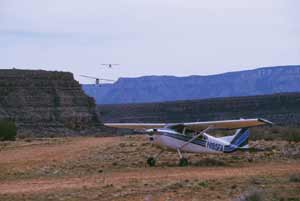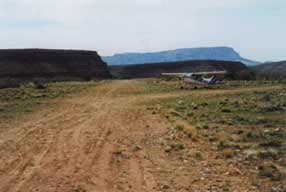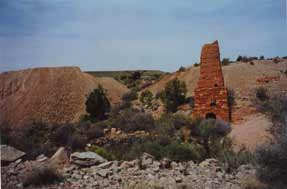|
|

| The Grand Gulch Mine |
| Arizona's Richest Copper Mine (in 1911, that is) |
By Scott Mahnken and Hal Hilburn
|

|
If you are accustomed to flying high speed forward for the legendary $100 hamburger, consider a new adventure. Fly backwards in history to a place with only echoes and ghosts from a century long ago, dead memories, and Arizona history blowing away as dust in the wind. If you want a sandwich, bring it. It’s a good idea to pack water too, because there are absolutely no services at this destination. The last time food, drink, or shelter was found here in the middle of the Arizona strip was in 1958. Back then you had to be employed in the last gasp effort to squeeze a bit more value from old tailings around a hole in the ground.
 Because buildings, machines, and diggings are well preserved in the dry desert climate of the Arizona strip, it is difficult to guess ages and eras. Our research revealed that the first mine claim for these 21 acres was filed in St George Utah, presumably because it was the closest settlement. In 1873 someone decided the claim, then called the Adam’s Mine, was definitely in Arizona, so it became the Grand Gulch Mining Co., filed in Kingman, Arizona. By whatever name the diggin’s are called, they are still a long ways from anyplace else. The airstrip at Grand Gulch is 47 air miles southwest of St. George airport (SGU), or 129 miles of bone-jarring bad road, much of it requiring an off-road vehicle. In the early days, the ground transportation to the mine was several days by wagon, at a cost of $6 one way. Today AV-gas might run the cost up a little, but if you can’t make the trip in less time, either the wind is too high or your engine needs attention! Because buildings, machines, and diggings are well preserved in the dry desert climate of the Arizona strip, it is difficult to guess ages and eras. Our research revealed that the first mine claim for these 21 acres was filed in St George Utah, presumably because it was the closest settlement. In 1873 someone decided the claim, then called the Adam’s Mine, was definitely in Arizona, so it became the Grand Gulch Mining Co., filed in Kingman, Arizona. By whatever name the diggin’s are called, they are still a long ways from anyplace else. The airstrip at Grand Gulch is 47 air miles southwest of St. George airport (SGU), or 129 miles of bone-jarring bad road, much of it requiring an off-road vehicle. In the early days, the ground transportation to the mine was several days by wagon, at a cost of $6 one way. Today AV-gas might run the cost up a little, but if you can’t make the trip in less time, either the wind is too high or your engine needs attention!
The history of the airstrip is not as well documented as the mine itself. We believe the first airstrip was scrapped out in the 1930’s by dragging a rock-covered bedspring through the sage, just good enough for Cubs and some Stinsons to bring in supplies to the isolated claim. Today, “Grand Gulch International” boasts two crossing packed dirt runways. The main strip, 16/34, is approximately 2500 x 35 feet of smoothed dirt, and works well for no wind conditions. The first 300 to 400 feet of 16 is very rough and slopes up significantly, so land a little long to avoid the rocks in the runway. The cross strip, 02/20, is around 2000 x 35 feet and has a few whoop-de-dos, but it works well when the southwesterly desert winds blow in the afternoon. Thanks to a nearly yearlong cleanup, the field is now suitable for just about any taildragger, and even the more robust varieties of tricycle gear aircraft.
 The mine is depicted on the Las Vegas Sectional Chart, a little north of the Pearce Ferry airstrip, at N 36° 19.63, W 113° 47.13, with the crossed-pick symbol for a mine. It is on the St. George VOR 180-degree radial at 47 nautical miles. Field elevation is 4500 (+/-) MSL, so be sure to check density altitude. From a low pass, you will see the windsock near the runway intersection. The mine is depicted on the Las Vegas Sectional Chart, a little north of the Pearce Ferry airstrip, at N 36° 19.63, W 113° 47.13, with the crossed-pick symbol for a mine. It is on the St. George VOR 180-degree radial at 47 nautical miles. Field elevation is 4500 (+/-) MSL, so be sure to check density altitude. From a low pass, you will see the windsock near the runway intersection.
On landing and rollout – in addition to watching for the few remaining rocks – try to avoid the cow-pies, and the animals that deposit them on the airstrip. Residue cow-pie under your wings may look like mud, but it has a distinctly different odor.
There are two cleared parking areas, though both are fairly rough and overgrown. One is by the windsock (which makes for a great photo), and the other is east of the crossing runways. Both areas have wire rope tie-down anchors well embedded in the ground. If you plan to camp overnight, the east parking area offers easier access to exploring the scenic canyons that surround the airstrip.
After parking, tying down, and checking the wings for “mud,” it’s time to explore. If you follow the small road that begins at the windsock for about a quarter of a mile, you will step back in time to the turn of the last century. Most of the buildings you see at the Grand Gulch Mine were constructed around 1900. The short walk leads past the powder bunker, an outhouse, then to the bunkhouse/ kitchen/power house. Further along are stone walls, scattered sinter bricks, ores, aging trucks, even trash dumps. Across a swale rises the magnificent original smelter, built in 1900. Even upon close examination, you may think the adobe and brick smelter is newer and virtually unused. This is half-right; despite the chimney’s size and beauty, the design was faulty, so it never worked. A little further on is the mineshaft and associated support equipment.
 The digging at the Grand Gulch started shortly after a Shivwits Indian brought some green rocks to St. George. Within a few years, miners had chased the deposit down to 60 feet. By 1913 the shaft was down more than 500 feet, even though no ore was ever found below the 300-foot level. The gallows, or headstock, still stands at the top of the vertical shaft. The hoist foundation for the mighty one lung 22-horsepower engine can be identified near the water holding cells. This engine lowered men, lifted ore, and pumped air into the dark shaft. Ore was mined from thin lenticular, nearly circular veins, often only inches thick. As recently as 1920 geologists had no understanding of the mineral’s origin. Belief then was that the ore was deposited by a percolation down from the surface, followed by some miraculous condensation deep underground. No consideration was given to the surface source of the minerals, even though no traces of ore were found in the vicinity. We know now the ore deposit lie around a breccia pipe. Visualize a vertical tunnel deep into the hot earth through which mineral gasses breathed up to condense into ore. Eons later the pipe filled with limestone from the surface. If you want to impress your flying buddies at the airstrip, remember that some of these ores are called brochantite, chrysocolla, chalcocite, and the better-known azurite and malachite. The digging at the Grand Gulch started shortly after a Shivwits Indian brought some green rocks to St. George. Within a few years, miners had chased the deposit down to 60 feet. By 1913 the shaft was down more than 500 feet, even though no ore was ever found below the 300-foot level. The gallows, or headstock, still stands at the top of the vertical shaft. The hoist foundation for the mighty one lung 22-horsepower engine can be identified near the water holding cells. This engine lowered men, lifted ore, and pumped air into the dark shaft. Ore was mined from thin lenticular, nearly circular veins, often only inches thick. As recently as 1920 geologists had no understanding of the mineral’s origin. Belief then was that the ore was deposited by a percolation down from the surface, followed by some miraculous condensation deep underground. No consideration was given to the surface source of the minerals, even though no traces of ore were found in the vicinity. We know now the ore deposit lie around a breccia pipe. Visualize a vertical tunnel deep into the hot earth through which mineral gasses breathed up to condense into ore. Eons later the pipe filled with limestone from the surface. If you want to impress your flying buddies at the airstrip, remember that some of these ores are called brochantite, chrysocolla, chalcocite, and the better-known azurite and malachite.
 Regardless of origin, it was a rich deposit. Though sparse, the veins were more than 14 percent copper, and also contained silver and lead. History varies on the destination of these ores (maybe Salt Lake City), but historians do agree the trip began with a brutal forty-mile horse and wagon trip down a treacherous draw to St Thomas, Nevada, a site now under Lake Mead. Even in the days before the IRS, the mine’s financial records were sketchy, murky, incomplete, and clouded in obscurifications. However, we do find the fortunes of the Grand Gulch Mine rose and fell through the century. The mine was once the richest copper mine in Arizona, then years later sold for a mere six dollars and ninety-seven cents. In 1917 employment was 75 men and women, each earning $10 more than cow punching. In 1918 the mineshaft burned down. Well, actually the timbers all caught fire… and there were a lot of timbers in the mine, since the miners had decimated the jack and red pine forests on the Shivwits Plateau 25 miles to the east. In 1955, someone threw nearly one million dollars into reworking the mine tailings, plus searching for new deposits. It was a financial disaster. Perhaps it is just as well that no new deposits were found, because it’s still 40 mean mule miles down the draws to Lake Mead. The mine has been derelict since 1958. Regardless of origin, it was a rich deposit. Though sparse, the veins were more than 14 percent copper, and also contained silver and lead. History varies on the destination of these ores (maybe Salt Lake City), but historians do agree the trip began with a brutal forty-mile horse and wagon trip down a treacherous draw to St Thomas, Nevada, a site now under Lake Mead. Even in the days before the IRS, the mine’s financial records were sketchy, murky, incomplete, and clouded in obscurifications. However, we do find the fortunes of the Grand Gulch Mine rose and fell through the century. The mine was once the richest copper mine in Arizona, then years later sold for a mere six dollars and ninety-seven cents. In 1917 employment was 75 men and women, each earning $10 more than cow punching. In 1918 the mineshaft burned down. Well, actually the timbers all caught fire… and there were a lot of timbers in the mine, since the miners had decimated the jack and red pine forests on the Shivwits Plateau 25 miles to the east. In 1955, someone threw nearly one million dollars into reworking the mine tailings, plus searching for new deposits. It was a financial disaster. Perhaps it is just as well that no new deposits were found, because it’s still 40 mean mule miles down the draws to Lake Mead. The mine has been derelict since 1958.
After that last million-dollar investment, it could be said that the Grand Gulch has devoured more dollars than it ever yielded. So, when you go, throw a penny down the shaft. The copper may appease the gods, and you will be the latest to throw good money after bad into a hole in the ground.
 The airstrip and surroundings are on public-use BLM land, however the Grand Gulch Mine is still an active claim and is therefore private property. Keep this in mind as you explore, and do not remove any artifacts or tamper with anything you find. Recently several of the site’s nearly intact buildings have, unfortunately, been severely vandalized by hoodlums passing through in four-wheelers. Perhaps, through the notoriety generated by this article, the threat of being spotted and reported by visiting pilots will help deter future vandals. The airstrip and surroundings are on public-use BLM land, however the Grand Gulch Mine is still an active claim and is therefore private property. Keep this in mind as you explore, and do not remove any artifacts or tamper with anything you find. Recently several of the site’s nearly intact buildings have, unfortunately, been severely vandalized by hoodlums passing through in four-wheelers. Perhaps, through the notoriety generated by this article, the threat of being spotted and reported by visiting pilots will help deter future vandals.
Before departure, it is a good idea to walk the runway to pick up any and all rocks that look like they could cause tire damage. Not only will you be saving your own aircraft, but also you will be helping maintain the runway for the next visitor. That is how backcountry airstrips are maintained – lots of landings and a little human effort.
|
Despite the cost of fuel, and the penny, a visit to the Grand Gulch Mine is well worthwhile. Plan to spend a minimum of two hours for even an abbreviated trip into the past. You are guaranteed to find interest, awe, and new knowledge at the Grand Gulch. If not, you can have your penny back.
|
Click here to return to the beginning of this article.  |
|